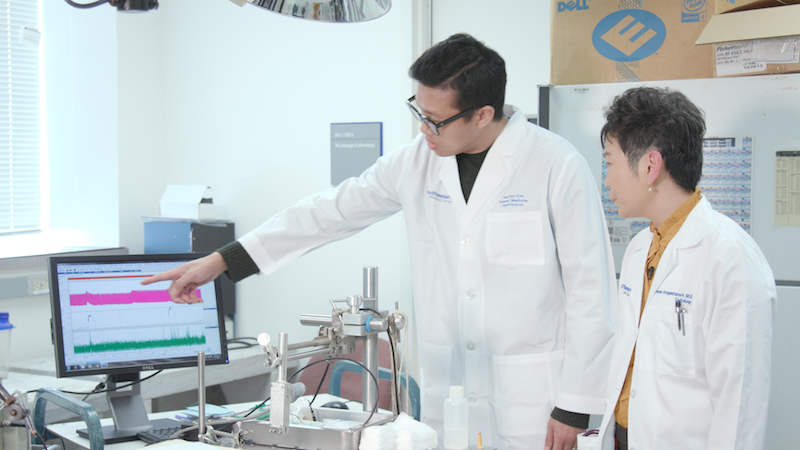Stuck on the couch? Good exercise habits derailed by common food additive
DALLAS – Jan. 7, 2019 – Inorganic phosphate, a food additive and preservative used in up to 70 percent of food in the American diet, may be contributing to couch potato behavior.
“We should not consume more than 700 milligrams of inorganic phosphate per day, but about one-third of people consume three to four times that amount,” said Dr. Wanpen Vongpatanasin, Professor of Internal Medicine and Director of the Hypertension Fellowship Program at UT Southwestern Medical Center. “Like any nutritional ingredient, too little phosphate is harmful, but too much is also harmful.”

Adding to the problem is the lack of information on inorganic phosphate. Looking at food labels won’t help, Dr. Vongpatanasin said. “Currently there are no mandates or regulations for the food industry to label how much inorganic phosphate is in the food chain.”
The new study describing the adverse effects of excess consumption of phosphate is published in the journal Circulation.
Phosphate is plentiful in fruits and vegetables in its organic form, which does not cause problems because it is not absorbed. However, the body readily absorbs inorganic phosphate, and most people are consuming far too much of it. For example, cola drinks, processed meats, and prepared frozen foods typically contain this additive.
When the researchers studied mice that were fed a high-phosphate diet, they found measureable changes in their ability to exercise.
“We measured their oxygen uptake during exercise and found that their capacity for movement was much lower. The mice were unable to generate enough fatty acids to feed their muscles,” Dr. Vongpatanasin said. The researchers also looked for gene changes and found that many genes involved in skeletal muscle metabolism had changed levels after 12 weeks of the high phosphate diet.

In addition, the study analyzed data from participants in the Dallas Heart Study who wore physical activity monitors for seven days. The multiethnic participants, ages 18 to 65, had no kidney or heart problems and were not on medications. Researchers examined blood test results in this group and verified that the response to phosphate in humans was similar to that in mice. Higher phosphate levels were linked to reduced time spent in moderate to vigorous exercise, while sedentary time increased as phosphate levels climbed.
Since inorganic phosphate is widely used in the food supply, the UT Southwestern research team concluded that more studies are needed to further define the broader health impact of this substance. The Food and Drug Administration and the U.S. Department of Agriculture establish requirements for food labels in the U.S.
The Dallas Heart Study was initiated in 2000 with the primary goal of improving the diagnosis, prevention, and treatment of heart disease. It is the only single-center heart study of its size and multiethnic composition.
Dr. Vongpatanasin holds the Norman and Audrey Kaplan Chair in Hypertension and the Fredric L. Coe Professorship in Nephrolithiasis Research in Mineral Metabolism.
Other UT Southwestern researchers who contributed to this work include: Dr. Gary Iwamoto, Professor of Cell Biology; Dr. Jere Mitchell, Professor of Internal Medicine and Physiology; Dr. Scott A. Smith, Assistant Dean for Research, Professor and Acting Chair of Health Care Sciences; Dr. Han Kyul Kim, postdoctoral fellow in Cardiology; Dr. Luke I. Szweda, Professor of Internal Medicine; Dr. Rhonda Bassel-Duby, Professor of Molecular Biology; Dr. Carlos M. Castorena, Instructor of Internal Medicine; Dr. James Richardson, Professor Emeritus of Pathology; John M. Shelton, Operations Director of the Histo Pathology Core; Colby Ayers, Internal Medicine Faculty Associate; Dr. Jarett D. Berry, Associate Professor of Internal Medicine and Clinical Sciences; Dr. Venkat S. Malladi, Assistant Professor of Pathology; Dr. Ming Chang Hu, Associate Professor Internal Medicine and Pediatrics; Dr. Orson W. Moe, Professor of Internal Medicine and Physiology; and Dr. Philipp E. Scherer, Professor of Internal Medicine and Cell Biology.
Dr. Mitchell holds the S. Roger and Carolyn P. Horchow Chair in Cardiac Research, in Honor of Jere H. Mitchell, M.D. Dr. Berry is a Dedman Family Scholar in Clinical Care. Dr. Moe holds The Charles Pak Distinguished Chair in Mineral Metabolism and the Donald W. Seldin Professorship in Clinical Investigation. Dr. Scherer holds the Gifford O. Touchstone, Jr. and Randolph G. Touchstone Distinguished Chair in Diabetes Research.
About UT Southwestern Medical Center
UT Southwestern, one of the premier academic medical centers in the nation, integrates pioneering biomedical research with exceptional clinical care and education. The institution’s faculty has received six Nobel Prizes, and includes 22 members of the National Academy of Sciences, 17 members of the National Academy of Medicine, and 15 Howard Hughes Medical Institute Investigators. The faculty of more than 2,700 is responsible for groundbreaking medical advances and is committed to translating science-driven research quickly to new clinical treatments. UT Southwestern physicians provide care in about 80 specialties to more than 105,000 hospitalized patients, nearly 370,000 emergency room cases, and oversee approximately 2.4 million outpatient visits a year.
